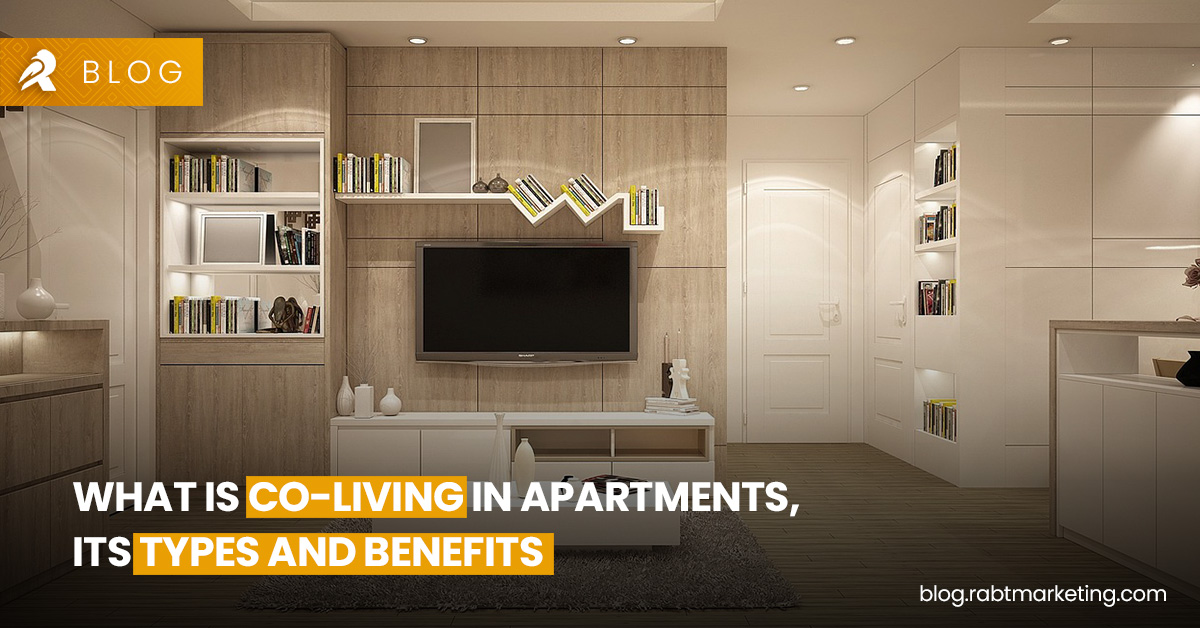The term “co-living in apartment” is a new trend inthe world of real estate and has got a significant value in recent years, giving living together a more modern twist. This is an example of a contemporary shared living strategy that goes beyond traditional housing arrangements. It entails people living together in shared housing, with an emphasis on the sharing of resources, financial obligations, and a sense of community.
Co-living apartments is characterized by flexible rental agreements, innovative amenities, and a strong sense of community. This enables individuals to reside in prime commercial areas while adhering to their budget constraints.
Co-living is all about having flexible rental agreements, cool amenities, and a great sense of community. It lets people live in really good areas without spending too much money.
Today, we will discuss in detail into the concept of co-living in apartments, and also talk about its pros and cons.
What is Co-Living in Apartments
Co-living is an emerging form of housing where residents have private bedrooms in furnished houses but share common areas with other residents. It essentially mirrors a sophisticated roommate situation. Primarily catering to millennials and young professionals, co-living often offers private or shared bedrooms within larger units and access to communal spaces such as kitchens, living rooms, and sometimes co-working areas.
The Popularity of Co-Living Apartments
Co-living is well known for its flexibility, enabling individuals to sign short-term leases and move in and out with ease. But it’s not only for transitory visits. Long-term residents can also find accommodations in co-living spaces. This provides a sense of community and security for people looking for a longer-term housing choice.
Types of Co-Living Arrangements
The world is contantly changing but this trend has led to diverse co-living arrangements, ranging from informal setups to luxurious bungalows. Here are the top five types:
Informal Co-Living Arrangements
In this type of living, a group of people collaborate, lease a space and furnish it according to their needs.
Adult Dorms
Adult dorms, also known as co-living spaces, are a type of housing that offers private bedrooms and shared common areas, such as kitchens, living rooms, and bathrooms. They are typically geared towards young adults who are looking for affordable housing in urban areas.
Co-ops
Cooperative housing involves members contributing to shared responsibilities like cleaning and cooking in larger houses with 15 to over 100 residents.
Luxury Co-living
This kind of living ensures a top notch and lavish lifestyle.It Provides high-end accommodation with premium amenities and services, often targeting professionals and executives.
Student co-living
It is Designed for students seeking affordable and convenient housing near their universities or colleges.
Bungalow
This smaller-scale co-living model converts single-family homes into shared spaces, fostering a more intimate community with an average of 4 or 5 residents, each with a private bedroom.
Pros of Co-Living in Apartments
Among the numerous advantages, some key benefits of co-living in apartments include:
Affordability
Co-living typically offers more affordable housing options compared to traditional apartments, particularly in major cities where rents are high. Residents can share the cost of rent, utilities, and amenities, significantly reducing their living expenses.
Convenience
Co-living apartments are often fully furnished and equipped with modern amenities, eliminating the need for residents to purchase furniture or appliances. Additionally, many co-living providers offer services such as cleaning, laundry, and maintenance, making life easier for residents.
Socialization
Co-living promotes socialization and creates a positive sense of collaboration and community and provides tenants the chance to meet people who share their interests. Shared meals, communal spaces, and well-organized events. Shortly, it create a supportive social environment.
Safety and Security
Security and safety is always main concern for residents of any locality.Living with others provides a strong sense of security, with more people available to assist in emergencies.
Environmental Benefits
Co-living contributes to environmental stability by reducing individual carbon footprints through shared resources.
Cons of Co-Living
While co-living offers various benefits, there are some disadvantages and downsides:
Personal Privacy
Privacy concern always exist in co-living style. Shared living may compromise individual control over living environments, challenging those who prefer isolation.
Diversified Backgrounds
It can be difficult for some individuals to adjust with the people of different backgrounds. Diverse backgrounds may lead to conflicts and disputes due to varying sleep cycles, work needs, or social preferences.
Responsibility for Others
Co-living demands consideration for others, which may not suit individuals who prefer independent living.
Read More:- What is a Studio Apartment and What are their Types and Benefits
Read More:- How to Find a Professional and Trustworthy Real Estate Agent
Frequently Asked Questions (FAQs)
Addressing common queries about co-living in apartments:
Q. What is co-living ?
Ans. Co-living involves individuals or groups sharing a living space, emphasizing the sharing of financial burdens, resources, and a sense of belonging.
Q. What is co-living in apartments?
Ans. It defines shared living spaces within apartments, including kitchens, living rooms, offices, and leisure areas, often with short-term or flexible leases.
Q. What are the different types of co-living arrangements?
Ans. Co-living arrangements range from informal setups and adult dorms to co-housing and bungalows.
Q. What is the difference between co-living and serviced apartments?
Ans. Co-living emphasizes shared spaces, while serviced apartments prioritize individual privacy.
Q. What are the main advantages of choosing a co-living arrangement?
Ans: Co-living offers several advantages, including cost-effective living through shared expenses, a strong sense of community, and flexibility with short-term leases. Residents also benefit from fully-furnished units, inclusive utilities, and the integration of modern technology into living spaces.
Q. Are co-living apartments only suitable for short-term stays?
Ans. Co-living is famous for being flexible, allowing people to easily move in and out with short-term leases. However, it’s not just for short stays. Some co-living setups are also designed for people who want to stay for a longer time. This offers stability and a feeling of community for those seeking a more extended housing option.
Conclusion
Co-living presents a unique and appealing residential option for those seeking affordability, convenience, and a vibrant social environment. With its flexible arrangements, shared amenities, and community-focused approach, co-living is one of the best modern residential experience that resonates with many individuals. Whether you’re a student, a young professional, or a digital nomad, co-living can provide a comfortable, connected, and cost-effective place to call home.

